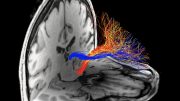
Two recent studies have employed advanced technology to model early human brain development to better understand schizophrenia. The first study used brain organoids to uncover persistent axonal dysregulation as a potential early contributor to schizophrenia. The second focused on the CYFIP1 gene within a specific genetic risk locus, emphasizing the gene’s potential role in microglial function and its association with neurodevelopmental disorders like schizophrenia and autism.
New stem cell research opens up new opportunities for discovery.
Schizophrenia is a complex neuropsychiatric disorder, the intricacies of which are not yet fully grasped. While its symptoms usually manifest during late adolescence or early adulthood, it’s believed that its roots can be traced back to neurodevelopmental abnormalities. Because human prenatal and postnatal brain tissue is exceedingly difficult to procure and therefore study, researchers have had limited opportunities to identify early disease mechanisms, especially during the critical prenatal period.
Now, a pair of studies that appear in Biological Psychiatry, published by Elsevier, use new technology to study schizophrenia in models of early human brain development.
Brain Organoids and Schizophrenia
The first study used a unique approach involving three-dimensional brain organoids, which are known to recapitulate fetal brain development. The researchers, led by first author Ibrahim A. Akkouh, Ph.D., and senior author Srdjan Djurovic, Ph.D., both at Oslo University Hospital, collected skin cells from 14 patients with schizophrenia and 14 healthy controls and generated induced pluripotent stem cells (iPSCs), which they then manipulated to develop into brain-like cortical spheroids.
The organoids grown from patients and controls differed in their expression of thousands of genes – in line with the finding that the genetic influences on schizophrenia are many and very small. However, among the genes, those associated with neuronal axons stood out as a group.
Dr. Akkouh explained, “We identified persistent axonal dysregulation as an early contribution to disease risk.”
Importantly, the researchers assessed organoid maturation at several time points, which enabled them to establish the persistent nature of the disturbances throughout development.
Dr. Akkouh added, “Our findings provide novel and hitherto inaccessible insights into the molecular basis of schizophrenia during early brain development.”
Role of the CYFIP1 Gene
In the second study, researchers led by Roy H. Perlis, PhD, at Harvard Medical School, focused on a particular genetic risk locus. The schizophrenia risk locus 15q11.2, a particular chromosomal region containing four genes, has a penetrance of over 10%, translating to a doubling of risk for schizophrenia among people carrying an unusual copy number of this genetic region. One gene in the locus, CYFIP1, has been associated with synaptic function in neurons and confers increased risk for neurodevelopmental disorders including schizophrenia and autism.
CYFIP1 is highly expressed in microglia, the brain’s own immune cells, but its function there is unknown. Microglia are known to carry out synaptic pruning, in which they “eat” excess synaptic structures, a process critical to healthy brain development.
Dr. Perlis and colleagues collected blood cells from healthy volunteers and isolated iPSCs, which they then manipulated to differentiate into microglia-like cells. The researchers then used CRISPR technology to remove functional CYFIP1 from the cells.
Dr. Perlis said of the work, “Our findings suggest that changes in the behavior and function of microglia due to aberrant CYFIP1 function, such as through coding or copy number variants, could affect microglial processes such as synaptic pruning, homeostatic surveillance, and neuronal maintenance, which are critical for proper brain development and function. This could contribute to CYFIP1-related neurodevelopmental and psychiatric disorders resulting in part from microglia dysfunction. Among the specific disorders linked to variation in CYFIP1 are both autism and schizophrenia.”
Concluding Thoughts
John Krystal, MD, Editor of Biological Psychiatry, commented, “The biology of schizophrenia is very complex and yet two themes represented by these two studies seem to be very important: the increased rate of elimination of glutamatergic synapses during development, and disturbances in the signaling properties of these glutamate synapses. These two disturbances could perturb circuit function in ways that are critical to the development of symptoms and cognitive impairments associated with schizophrenia.”
Dr. Perlis added, “More broadly, our findings highlight the importance of looking beyond neurons to understand risk genes. While finding risk loci may be the first step in understanding the role of genes in brain diseases, it’s only a first step; figuring out the relevant cell type, and what those genes are doing, is absolutely critical in moving from association to – we hope – actual treatments.”
References: “Longitudinal Transcriptomic Analysis of Human Cortical Spheroids Identifies Axonal Dysregulation in the Prenatal Brain as a Mediator of Genetic Risk for Schizophrenia” by Ibrahim A. Akkouh, Thor Ueland, Attila Szabo, Timothy Hughes, Olav B. Smeland, Ole A. Andreassen, Jordi Requena Osete and Srdjan Djurovic, 3 September 2023, Biological Psychiatry.
DOI: 10.1016/j.biopsych.2023.08.017
“Loss of Function in the Neurodevelopmental Disease and Schizophrenia-Associated Gene CYFIP1 in Human Microglia-like Cells Supports a Functional Role in Synaptic Engulfment” by Steven D. Sheridan, Joy E. Horng, Hana Yeh, Liam McCrea, Jennifer Wang, Ting Fu and Roy H. Perlis, 11 August 2023, Biological Psychiatry.
DOI: 10.1016/j.biopsych.2023.07.022









Be the first to comment on "Scientists Uncover New Clues to Early Development of Schizophrenia"